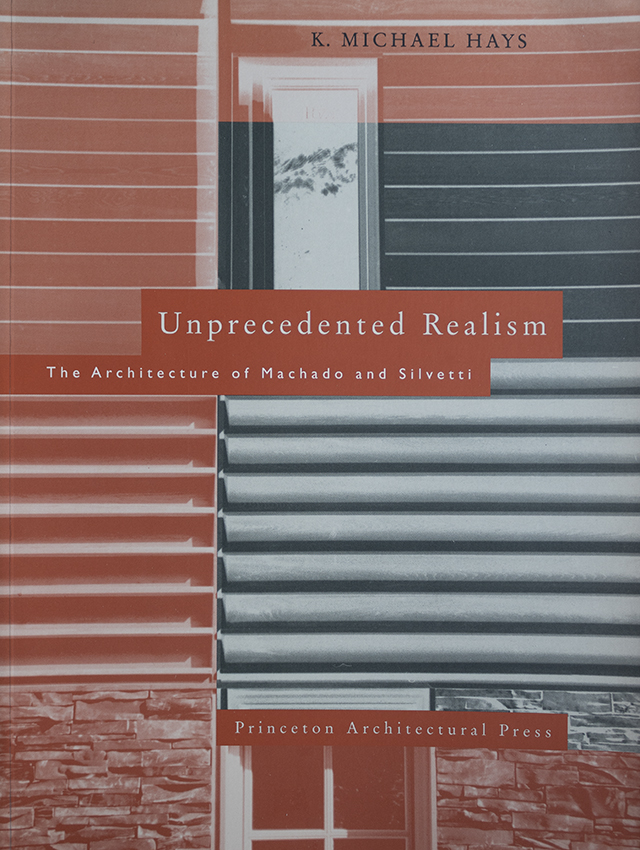Unprecedented Realism
Unprecedented Realism: The Architecture of Machado and SilvettiK. Michael HaysPrinceton Architectural Press, 1995Paperback | 9 x 12 inches | 280 pages | 248 illustrations | English | ISBN: 978-0910413602 | $40.00PUBLISHER'S DESCRIPTION: For almost two decades the work of Rodolfo Machado and Jorge Silvetti has remained at the forefront of theoretical production. Their rigorously detailed and exquisitely drawn projects characterize an attitude of aesthetic realism towards materials, construction, function, and the cultural role of architecture. Yet the conditions they address, and the effects they produce, are unprecedented. Their projects synthesize seemingly incompatible images, uses, and typologies. Unprecedented Realism is not an illustration of theory. Rather what emerges is a constructive theory of architecture that understands the process of design itself as a distinct mode of knowledge as theoretical research that is still irreducibly architectural. The book presents a range of work from buildings to urban infrastructures. Some of the projects presented include Steps of Providence, Rhode Island; Entrance for Cranbrook, Bloomfield Hills, Michigan; Carnegie-Mellon University Center, Pittsburgh; Pershing Square, Los Angeles; and Times Square, New York. Along with the analytical text of K. Michael Hays, the volume includes critical essays by Alan Colquhoun, George Baird, Fares el-Dahdah, and Rodolphe el-Khoury. K. Michael Hays is Eliot Noyes Professor of Architectural Theory at the Harvard University Graduate School of Design and Director of the Master in Design Studies program. Hays joined the Faculty of Design in 1988, teaching courses in architectural history and theory. REFERRAL LINKS: dDAB COMMENTARY: My comments about Machado and Silvetti's Stone Barns Center in the book The New Farm a couple days ago prompted me to pick my copy of Unprecedented Realism off the shelf. Published in 1995, it is one of the first monographs on the Boston firm founded by Rodolfo Machado and Jorge Silvetti in 1985. Both partners have taught at Harvard GSD since 1986, and another longtime professor, K. Michael Hays (at GSD since 1988), was responsible for this monograph billed as "a constructive theory of architecture that understands the process of design as ... theoretical research that is still irreducibly architectural." This description captures the state of architecture at the time — a profession influenced by cultural and philosophical ideas that originated outside of architecture, namely post-structuralism and deconstruction — as well as Machado and Silvetti's desire to move beyond them in favor of what they describe as "a real formulation of the theory and practice of architecture in the real conditions of the world today." These words are found in the afterword penned by the architects, coming after more than 250 page of dense theorizing tucked between and layered upon 27 of their projects. The texts are a mix of old essays written by Machado and Silvetti, their own project descriptions, long explications by Hays in the introduction and the start of each chapter ("Realism," "Emergent Types," "Mise-en-Architecture," and "Polygraphic Excess and Polyscopic Regimes"), and essays contributed by Rodolphe el-Khoury, George Baird, and Farès el-Dahdah. The book's prevailing duotone imagery — evident on the cover and nearly every page inside — extends to the texts, with older essays by Machado and Silvetti in sepia standing apart from the rest but sharing the page with them (visible on the first spread below). Though not as trendy or obnoxious as Semiotext(e) Architecture from 1992, the layout of Unprecedented Realism is very much of its time: it intertwines the content in a way that allows multiple readings and breaks down any hierarchy between elements. I bought the book when it came out because I was more interested in the theory than the architecture; 25 years later my interests have flip-flopped and I'm more drawn to the drawings and the designs they represent. Although at the time I would have described Machado and Silvetti as Postmodern architects (I mean, look at that metal cornice on the Princeton University parking garage!), today I view their work from decades ago as more nuanced, more in line with regionalism than postmodern irony. My favorite projects are the public spaces: the Steps of Providence on the campus of RISD, for instance, and Four Public Squares in Leonforte, Sicily. These and other projects (most of their projects at the time were just that, unbuilt projects) express a strong concern for context and of using their designs to stitch together existing places in creative ways. That thinking led to such built gems as Robert F. Wagner, Jr. Park at the southern tip of Battery Park City. Unfortunately, the park and its brick pavilion are threatened with demolition as plans for the resilient shoreline of Lower Manhattan move forward — without incorporating the "beloved pavilion." SPREADS:


K. Michael Hays
Princeton Architectural Press, 1995
Paperback | 9 x 12 inches | 280 pages | 248 illustrations | English | ISBN: 978-0910413602 | $40.00
PUBLISHER'S DESCRIPTION:
REFERRAL LINKS:
SPREADS:








